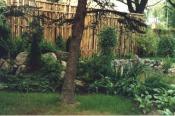Search
Login
DIY site drainage
It's nice when your house and land serves you to relax. When at any time of the year you can walk along the paths of the garden, sit in the shade of trees and not carry kilograms of dirt on your shoes. And this is a perfectly reachable reality. Just from the very beginning you need to correctly approach all the problems associated with the arrangement of the site and, of course, with the land, with the strengthening of the slopes, for which you need to buy a geo-shaped profile that is laid to strengthen the slopes.
Content
- What is drainage?
- Surface drainage video
- Depth Retraction video
- What is draene
- Sizes of water inlet openings of drainage pipes (drains)
- Drainage Depth
- Do-it-yourself drain filter device
- Drainage slope
- Creating manholes
- Drain system installation sequence video
- Errors during drainage
What is drainage?
The reference material explains that drainage is a system of ditches and pipes for draining the soil and lowering the level of groundwater. Reducing soil moisture can be achieved in two ways: the surface method and deep removal.
Surface method
With the surface method of arranging drainage, the territory is planned with the creation of slopes from the building, a drainage network with uphill ditches for intercepting water, pits and trenches is constructed.
Depth Retraction
Depth drainage is carried out to prevent flooding of foundations, basements of buildings and other underground structures, the necessary level of groundwater should be below the base of the structure, not less than 50 centimeters.
According to the type of arrangement of drainage pipes, single-line, bilinear, contour and areal drainage systems are distinguished.
Basically, an annular or contour system is common, with such a system drainage pipes or drains are located around the perimeter of the protected area, this system also includes inspection wells and structures for water discharge.
What is draene
Drain is a pipe with holes for receiving water, the holes can be round or slotted. A filter is poured around the drain; it consists of sand and gravel. The diameter of the drainage system is determined after a complex of survey works and the implementation of the project for drainage of the site.
When calculating the site drainage project, the basic characteristics of moisture saturation, soil filtration coefficient by season, volume of inflow and groundwater level, soil type, etc. are used.
Design and survey work costs a lot of money, and since the design and survey work on the site, their total cost is equal to the price of a drainage water supply system, many owners purchase a pipe (drain) without drawing up a project. The most popular diameter is 100 mm.
Sizes of water inlet openings of drainage pipes (drains)
The dimensions of the water inlet openings of the drainage pipes must be such that the dusting does not penetrate through them. For slotted holes, holes from 3 to 7 mm are accepted., The distance between them is 50-70 cm.
For round holes - from 5 to 15 mm, the total area of \u200b\u200bround holes can reach up to 0.5% of the total pipe surface area. Water inlets are located on the sides of the drains.
So that the holes are not silted, they are covered with geotextile, moss or felt.
Drainage Depth
The depth of the drainage depends on how much it is necessary to reduce the level of groundwater, as well as the system and type of drainage, the depth of freezing of the soil. Sometimes just a surface tap is enough.
In some cases, the problem is solved by the correct selection of waterproofing, its high-quality use in the processing of the foundation.
But in cases of close occurrence of groundwater, this problem is solved in conjunction with the laying of drainage, to remove excess moisture from the soil, in such cases, it is necessary to ensure the maximum flow of water to the drainage pipeline
Do-it-yourself drain filter device
To do this, it is necessary to increase the water permeability of the soil, an increase in water permeability is achieved by sprinkling drainage pipelines with filtration materials.
The filter with which the drains are sprinkled is a layer cake made of gravel, sand and gravel. Gravel is used fine (2-5mm.), Coarse sand (1-0.5), medium (0.5-0.25), fine gravel (20-5mm.) And especially fine (10-5mm.).
You must understand that the grain size of the filter must exceed the grain size of the soil more than 10 times. The presence of a filter increases the amount of water collected. So that the network does not silt, the speed of the water flow in the pipe should be at least 0.2 meters per second.
Drainage slope
To ensure this speed, drainage pipes should be laid with a slight slope - 1 centimeter per two meters of pipe. The site will be drained efficiently provided that it is guaranteed that water can be drained by gravity or with the help of a drainage pump into a street ditch, pond or well.
Creating manholes
To observe the work of drainage and clean the drainage lines, observation wells are arranged. They are usually prefabricated from concrete or reinforced concrete elements, the bottom of the well must be reliably waterproofed.
Viewing wells are usually arranged in places where the diameter, slope and direction of drains change.
Drain system installation sequence
- a drainage layer of crushed stone or gravel with a height of at least 15 cm is poured at the bottom of the dug trench (fractions of crushed stone or gravel less than 32 mm.);
- drainage slope (not less than 0.005) i.e. one centimeter per two meters of length;
- the pipeline is assembled from pipes and fittings (tees, bends, plugs) and laid on the drainage layer;
- from above the pipeline is filled up with a drainage layer 15 cm high, without disturbing the joints and without changing the slope;
- the trench is filled with water-permeable soil to ground level, a vegetative layer is laid on top.
Errors in the installation of the drainage system
The most common errors are:
- used pipes that are not intended for laying in this type of soil (for example, a pipe without a filter was laid in clay soil);
- drainage water pipe laid without filter dusting;
- slopes are not observed when the drainage device;
- the trench is not covered with filter soil;
- timely excess water is not drained from the catchment well.





